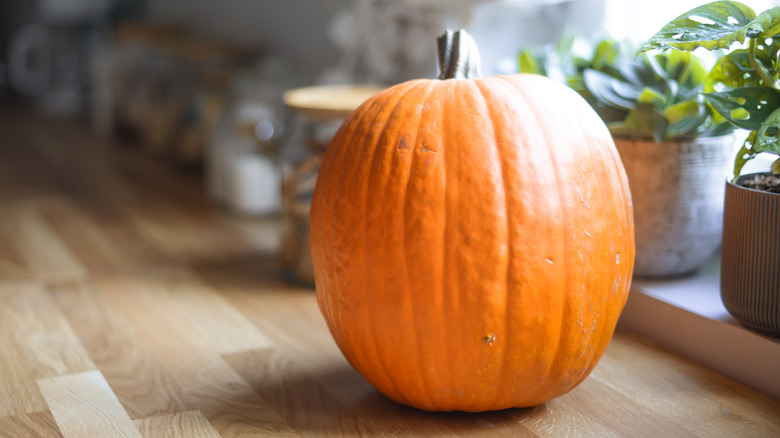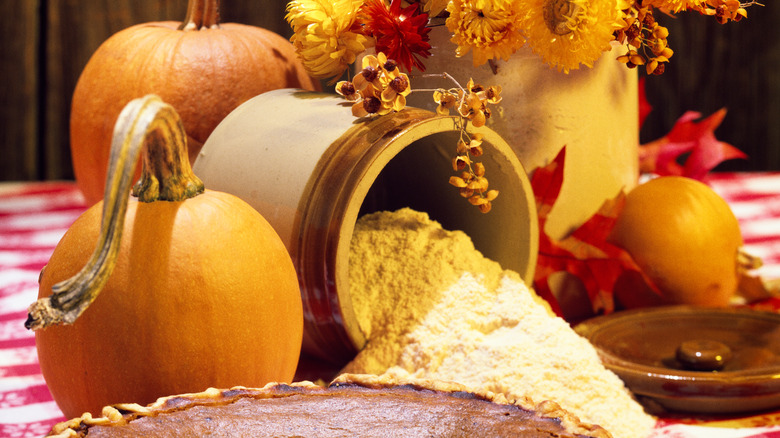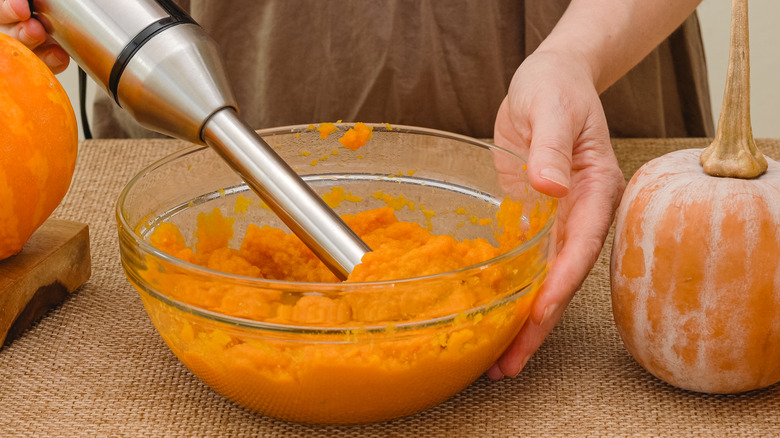Color Isn't Everything When Choosing A Pumpkin For Your Pie
Fall is the time for apple picking, cozying up in sweaters, and, most importantly, making pumpkin desserts! To make pumpkin pie, you won't be hunting down carving pumpkins, sometimes known as jack-o'-lantern pumpkins; instead, you'll be choosing a sugar pumpkin, also called a pie pumpkin. A sugar pumpkin is a small, round pumpkin with a smooth, bright orange exterior. That said, when most of us head to the supermarket to source gourds for turning into pumpkin pie and other fall delights, we often choose the prettiest, brightest-colored squash we can find.
However, the color of your pumpkin may not be as important as you think it is when you're picking out pumpkins for your next round of baking. You see, even though a pumpkin may look dull or old on the outside, the flesh on the inside is usually still just fine to eat. The only reason you might want to avoid a pumpkin based on its appearance is if you notice it's bruised or blighted.
Here are a few other things that you should keep in mind when looking for the main ingredient for a tasty pumpkin pie, and some tips on how to turn your pumpkin into pie filling once you've found the perfect one.
What to look for when picking the perfect pie pumpkin
Finding a good pumpkin, whether it's in a pumpkin patch or at the supermarket, can feel like a bit of a challenge. However, with a few tricks up your sleeve, you can actually get a great pumpkin without too much hassle.
As mentioned earlier, one thing to keep in mind is that the color of your pumpkin isn't a make-it-or-break-it factor when choosing which one to buy. Even though pumpkins may start to look old on the outside and their color may dull, as long as you don't see noticeable signs of damage or rotting, they should still be perfectly good for cooking on the inside — they just might not be jack-o'-lantern material. Still, with that noted, make sure you're thoroughly checking the pumpkin, especially the bottom, to rule out rot and ensure you really are getting a good gourd.
Besides checking the pumpkin's skin, you'll also want to make sure you're checking the stem. Pumpkins should have a dry, brown stem that's still solidly attached. If the stem is breaking off or already broken, it can make your pumpkin more likely to go bad, rendering it useless for baking. With that in mind, however, you're well on your way to choosing a great gourd.
Tips for turning fresh pumpkin into pie filling
Now that you've selected your perfect pumpkin, it's time to get to work making it into a tasty pie. Making pumpkin pie filling from scratch can be a lot of work, but it definitely pays off in the end.
The first trick to making pumpkins into pie filling is to wash the skin of the pumpkin. As you cook the pumpkin to puree it, you'll leave the skin on, so it's best to make sure it's clean to avoid dirt and debris getting into your pumpkin. Once you've washed the pumpkin, go ahead and cut it into large chunks. Remove the pumpkin seeds and bake the now seed-free pumpkin in the oven until it's tender before removing the flesh from the skin and throwing the skin away. Let the pumpkin cool, and then all you have to do is puree it in a blender or food processor (or use an immersion blender) until it's smooth.
Once you've processed your pumpkin puree, you may find that it's still quite liquidy. You can fix this by straining it through cheesecloth for an hour or so. When you're making your pie, you can also add a dash of cornstarch to help the pie filling firm up and set properly. Now, armed with these tips and the ability to choose the right pumpkin in the first place, you're ready to get to work making a delicious fall dessert.


